Otway Black Snail
Otway Black SnailVictaphanta compacta | |
|---|---|
| Kingdom: | Animalia |
| Phylum: | Mollusca |
| Class: | Gastropoda |
| Superorder: | Pulmonata |
| Family: | Rhytididae |
| Status | |
| World: | Endangered (IUCN 1996) |
| Australia: | Not listed (EPBC Act 1999) |
| Victoria: | Endangered (FFG Threatened List 2025) |
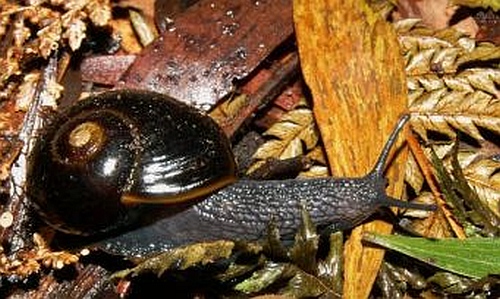
The Otway Black Snail Victaphanta compacta is only found in wet forests and cool temperate rainforests in the Otway Ranges, Victoria. It is one of four species of Victaphanta in the family Rhytididae, being carnivorous land snails and one of five species of carnivorous land snails found in the Otway Ranges but it is the only carnivorous land snail endemic to the Otway Ranges.
The Otway Black Snail was first described as Paryphanta compacta (Cox and Hedley 1912). In 1933 the genus Victaphanta was established (Iredale 1933).
Otway Black Snail feels the heat
Other species in the genus Victaphanta;
-
Victaphanta atramentaria - found in cool temperate rainforests in the Dandenong Ranges and the east-central part of the Great Dividing Range.
-
Victaphanta milligani - only in Tasmania
-
Victaphanta lampra - only in Tasmania (Smith and Kershaw 1979).
Identification
The body of the snail is grey-blue to black; the shell is spherical with four whorls and varies from a glossy dark brown to black with varying tinges of yellow-brown on the inner whorl. The shell has a maximum diameter of 28mm and is positioned towards the tail of the body. The shell is thin, light weight and moderately flexible and comprised mostly of conchin (Smith 1998).
The Otway Black Snail can be distinguished from other species of Vicaphanta because of its specific geographic range, globulous shaped shell, lack of an orange frill around its foot and an absence of orange mucus (Cox and Hedley 1912, Smith and Kershaw 1979).
A total of five species of carnivorous land snails in the family Rhytididae have been recorded in the Otway Ranges;
- Tasmaphena ruga,
- Rhytida capillacea,
- Prolesophanta dyeri,
- Strangesta gawleri,
- Victaphanta compacta. The Otway Black Snail is the only species endemic to the Otway Ranges and is the only species in the area to have a glossy dark brown to black shell (Smith1977, Smith and Kershaw 1979).
Distribution
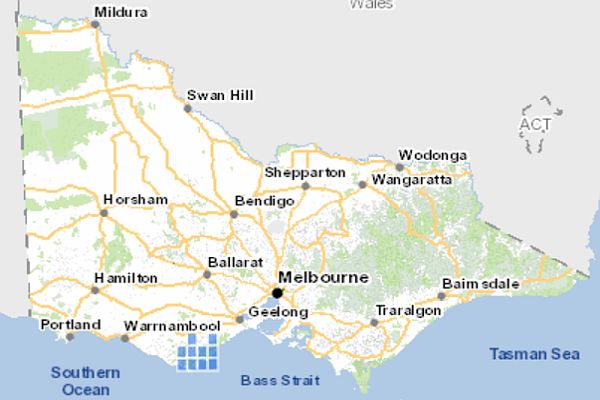
All known records of the Otway Black Snail in Victoria. Source: VBA 2024
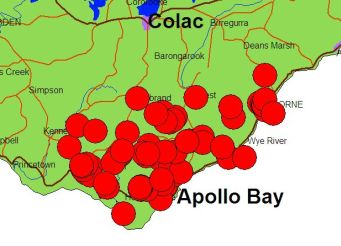
The Otway Black Snail stronghold is approximately a 900 sq km area of the Otway Ranges southwards between Lorne to Gellibrand to Lavers Hill.
Ecology & Habitat
The Otway Black Snail inhabits wet forest, cool temperate rainforest and the ecotone between these forest types (Burrell et al. 2007).
Wet forest
Ecological Vegetation Class (EVC 30) is dominated by Mountain Ash Eucalyptus regnanson wetter sites and mixed stands of Mountain Ash with Mountain Grey Gum Eucalyptus cypellocarpa and Messmate Eucalyptus obliqua, the latter more frequent at lower altitudes. Blackwood Acacia melanoxylon forms a tall secondary tree layer. The shrub layer is well established and is dominated by mesic shrubs including Musk Daisy-bush Olearia argophylla, Prickly Currant-bush Coprosma quadrifida, Austral Mulberry Hedycarya angustifolia and Blanket-leaf Bedfordia arborescens. Sclerophyllous, non-ericoid species, such as Bootlace Bush Pimelea axiflora, Hazel Pomaderris Pomaderris aspera, Banyalla Pittosporum bicolor, Satinwood Phebalium squameum and Privet Mock-olive Notelaea ligustrina are also common. There is an abundance and diversity of ferns in all strata as ground ferns, tree ferns or epiphytes. Soft Tree-fern Dicksonia antarctica is nearly always present, with the rare Slender Tree-fern Cyathea cunninghamii and Rough Tree-fern Cyathea australis sometimes co-occurring (Commonwealth of Australia 1999).
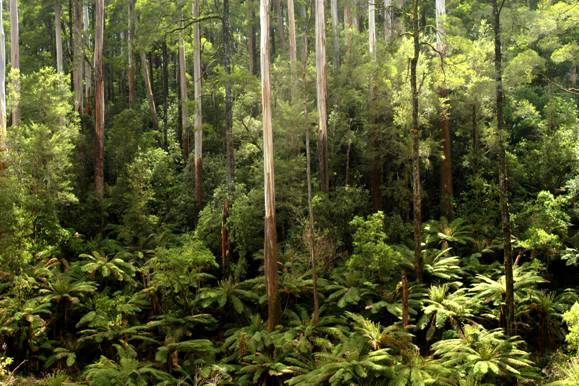
Cool temperate rainforests
(Ecological Vegetation Class (EVC 31) has an overstorey of well developed Myrtle Beech Nothofagus cunninghamii to 30m tall. The understorey is dominated by a dense canopy of Soft Tree-fern Dicksonia antarctica along with a diversity of understorey trees and tall, mesic shrubs including Prickly Currant-bush Coprosma quadrifida, Austral Mulberry Hedycarya angustifolia, Banyalla Pittosporum bicolor, Musk Daisybush Olearia argophylla and Blackwood Acacia melanoxylon. The rare Slender Tree-fern Cyathea cunninghamii is also commonly present. Other tree ferns commonly present include the rare Skirted Tree-fern Cyathea X marcescens and Slender Tree-fern Cyathea cunninghamii (Commonwealth of Australia 1999).
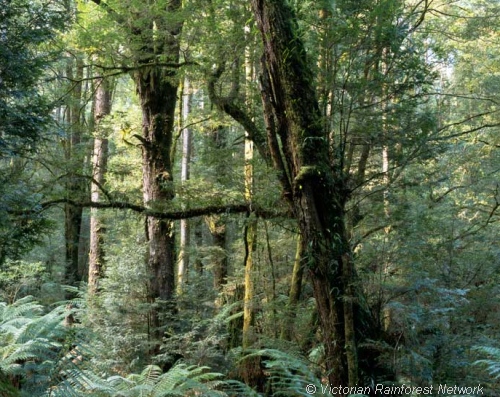
Habitat
Within suitable forest types the Otway Black Snail shows no particular habitat preference. It can be found equally on wet forest ridgelines, cool temperate rainforest gullies and slope ecotones. Preferred micro habitat is at the base of trees and tree-ferns and within deep leaf litter. It is less likely to be found in log debris and is unlikely to be found 2 metres above ground level (Burrell et al. 2007).
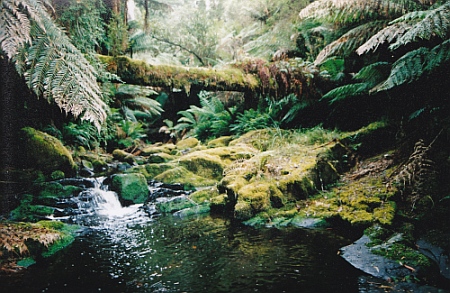
Feeding & reproduction
The Otway Black Snail is partially nocturnal. It is carnivorous, feeding on other snails slugs, earthworms and soft bodied insect larvae but is not cannibalistic (Smith 1971). It has no jaw as found in herbivorous snails but has long, sharp, backward pointing teeth arranged in v-shaped rows on the radula (underside of the foot of the snail) with the function of holding prey whilst it is devoured (Smith 1970, Smith and Kershaw 1979).
There is no published information on the longevity of the Otway Black Snail but studies by McLachlan (1951) of other members of the Rhytitidae family indicate the life span may be from 2-8 years. The Otway Black Snail lays eggs in clumps; eggs are white, 2-3 mm in diameter and have hard calcareous shells (Smith 1970).
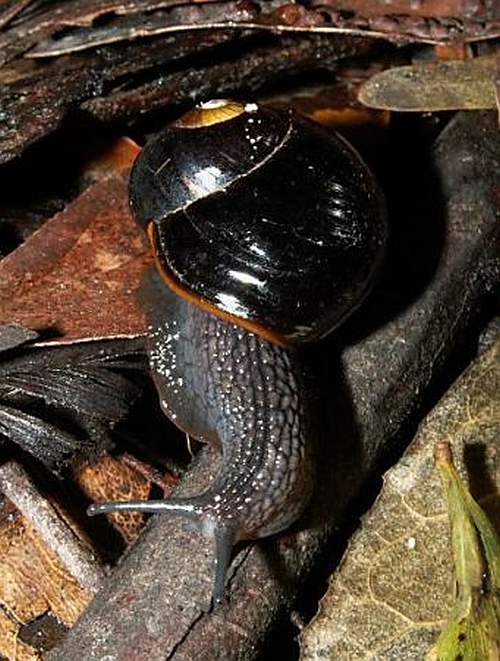
Threats
The Final Recommendation of the Flora and Fauna Guarantee Scientific Committee states that the Otway Black Snail is vulnerable to population decline resulting from damage and loss of the preferred habitat types as a result of Myrtle Wilt and activities by man that disturb the forest floor and overstory vegetation (timber harvesting, road construction, etc). The narrow distributional range of the species makes it prone to extinction as a result of stochastic events (SAC 2001).
Drought
The Otway Black Snail is reliant on moist conditions and is susceptible to desiccation when in dry conditions (Smith 1971). Prolonged periods of drought which dry out normally moist habitat may have an adverse impact on this species by reducing the extent of available habitat.
Fire
Because the Otway Black Snail is only found in a certain areas of the Otway Ranges and no where else in the world it is susceptible to catastrophic fire events.
Otway Black Snail feels the heat.
With an El Nino producing two years of below average rainfall in the Otways in 2014 & 2015 and a bushfire in prime habitat this endangered species is under increasing pressure for its survival. The Otway Black Snail is reliant on moist conditions and is susceptible to desiccation when in dry conditions (Smith 1971).
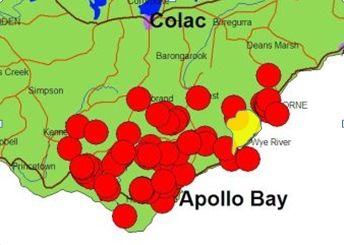
Conservation & Management
Land management
Threats from forest disturbance on Public Land have been significantly reduced with a phase out of timber harvesting in the Otways being completed by 2008. In addition recommendations of the Victorian Environment Assessment Council (VEAC) Angahook-Otway Investigation, 2005 lead to creation of the Great Otway National Park and Otway Forest Park which was declared open in December 2005. This has substantially increased protection of the Otway Black Snail habitat.
The Code of Practice for Timber Production 2007 is a key regulatory instrument that applies to commercial timber production in both public and private native forests and plantations in Victoria. It provides measures for ensuring sensitive areas such as riparian areas and gullies are protected from disturbance. This provides a degree of protection for Otway Black snails in such areas.
Surveys
There have been no regular surveys to determine the population trend for this species, but records indicate that the species is rare in terms of abundance and distribution and there may have been some contration in the northern portion of its range.
There have only been sparse records in recent years with counts not exceeding 1 specimen. A total of 3 records for 2023 and 1 record in May 2024 (VBA 2024).
References & Links
- Burrell, C., Scott, B., and Yen, A.L. (2007) Habitat preferences of the Otway Black Snail Victaphanta compacta (Cox and Hedley, 1912) (Rhytididae). The Victorian Naturalist Vol. 124 (4), 204-209.
- Commonwealth of Australia (1999) West Victoria Comprehensive Regional Assessment Report, In support of the West Victoria Regional Forest Agreement Process, Vol.2 Oct. 1999; 58-59, produced by the joint Commonwealth and Victorian Regional Forest Agreement (RFA) Steering Committee.
- Cox,J.C. and Hedley, F.L.S. (1912) An Index to the Land Shells of Victoria. Memoirs of the National Museum of Victoria, 4: 5-14, plates i-iii, February 1912.
- DSE (2009) Victorian Department of Sustainability and Environment, Advisory List of Threatened Invertebrate Fauna in Victoria – 2009. Department of Sustainability and Environment, East Melbourne, Victoria. See DELWP
- FFG Threatened List (Flora and Fauna Guarantee Threatened List) March 2025, Department of Energy, Environment and Climate Action (DEECA).
- Iredale, T. (1933) Systematic notes on Australian land snails. Records of the Australian Museum 19: 37-59.
- IUCN (1996) Mollusc Specialist Group. 1996. Victaphanta compacta. The IUCN Red List of Threatened Species 1996: e.T22951A9402284.http://dx.doi.org/10.2305/IUCN.UK.1996.RLTS.T22951A9402284.en. Downloaded on 31 December 2015.
- McLachlan, C.F. (1951) Basic work on the life cycle of some Australian snails. Proceedings of the Royal Society of New South Wales 1949, 50: 26-36.
- Smith, B.J. (1970) Notes on the anatomy of Victaphanta atramentaria (Shuttleworth) and Vicaphanta compacta (Cox and Hedley) and the designation of a neotype for V. atramentaria. Journal of the Malacological Society of Australia, 2: 13-21.
- Smith, B.J. (1971) Carnivorous Snails of the Family Paryphantidae, Australian Journal of Natural History, June 1971, pg. 55-58.
- SCA (2001) Final Recommendation on a nomination for listing – Victaphanta compacta (Cox & Hedley 1912) Otway Black Snail (Nomination 522) Flora and Fauna Guarantee Scientific Advisory Committee. (Department of Natural Resources and Environment, Melbourne).
- Smith, B.J. (1977) The Non-Marine Mollusc Fauna of the Otway Region of Victoria. Proceedings of the Royal Society of Victoria, 89: 147-155.
- Smith, B.J. and Kershaw, R.C. (1979) Field Guide to the Non-Marine Molluscs of South Eastern Australia. Australian National University Press, Canberra
- Smith, B.J. (1998) Family Rhytididae. Pp1091-1093, in Beesley, P.L., Ross, G.J.B. & Wells, A. (eds) Mollusca: The Southern Synthesis, Fauna of Australia Vol. 5. CSIRO Publishing, Melbourne.
- VBA (2024) Victorian Biodiversity Atlas, Department of Energy, Environment and Climate Action (DEECA), Victoria.

